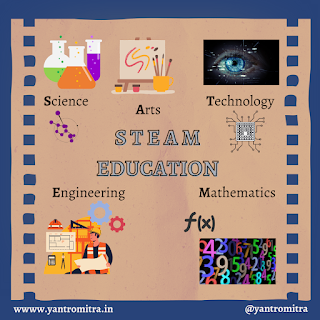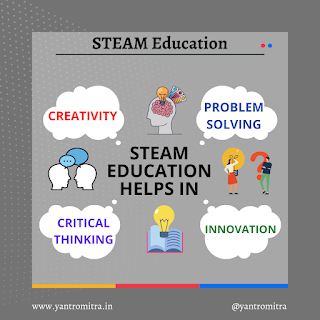You must have heard a lot of people talk about STEAM and read about it in the media, but what exactly does it mean and what does it stand for? Through this Yantromitra' blog we try to assist you in learning and comprehending everything there is to know and grasp about it.
What does STEAM stand for?
STEAM is an acronym that stands for Science, Technology, Engineering, Art, and Mathematics. STEAM education, which was developed in 2001 as an extension of STEM education, adds Art to the existing list of key areas.
What is STEAM education?
STEAM is an educational discipline that attempts to instill in youngsters a lifetime interest and appreciation of the arts and sciences from a young age. Science, Technology, Engineering, the Arts, and Math are all creative disciplines of study, yet none of them employ a single technique of inquiry and research. Teaching relevant, in-demand skills that will equip students to become innovators in an ever-changing environment is critical, not just for the kids' future but also for the country's future.
STEAM allows instructors to use project-based learning that spans all five disciplines and promotes an inclusive learning environment in which all students may engage and contribute. Unlike traditional teaching approaches, instructors utilising the STEAM framework integrate the disciplines together, for example, by exploiting the synergy between the modelling process and math and science material to blur the boundaries between modelling techniques and scientific/mathematical reasoning. Students may engage both sides of their brain at the same time with this comprehensive method.
STEM disciplines were initially brought together to equip students for the rising requirements of a global workforce that was beginning to prioritise these skill sets. There was a perceived lack of interest and enthusiasm among students for these topics at the time of its inception, therefore educators and institutions placed a stronger emphasis on these areas. However, as time has passed, a greater necessity has been felt to include art within these fields. This has resulted in the growth of STEAM education.
While some may argue that the inclusion of arts has diverted attention away from the core STEM education courses, the value of its integration cannot be overstated. Science, technology, engineering, mathematics, and the arts today have a strong and essential interaction. The addition of this fifth aspect helps students to be more creative in their approach to problem-solving, utilising the inventive and innovative abilities gained via study of the arts to connect these diverse areas.
This method to collaborative thinking prepares STEAM education students for life beyond graduation. STEAM education encourages inquiry and process-based learning rather than just pushing pupils to memorise knowledge for examinations and consider this as a success indicator. It prepares students for the sort of research-based approach necessary for higher education, as well as for the demands of the twenty-first century job.
Possessing a blend of creative and analytical abilities is more crucial than ever in today's work market, as positions become more complex and demand a suitably flexible skill set. STEAM occupations are expanding twice as fast as those outside of them, with employers now looking for a broader set of abilities in each candidate. For example, a graphic designer position may have historically just needed expertise in visual arts and design; now, the same function may include coding and programming, which are STEM abilities.
What
are the Benefits of Steam Education?
● Encourage companies to prioritize the arts in their hiring practices to spur creativity.
● Encourage the repositioning of many artistic disciplines at the forefront of education.
● By incorporating the arts into STEM teaching and research, we can improve both.
Based on these goals, the benefit of STEAM education is that it improves the quality, variety, and creativity of today's workforce by integrating many disciplines into schooling. The old strategy of teaching particular topics in isolation simply does not meet the demands of the current world, society, and workplace; merely teaching pupils how to pass tests in multiple areas is insufficient. STEAM education provides an interdisciplinary, collaborative environment.
Of the few companies offering STEAM education, YantroMitra Learning Technologies Pvt. Ltd. is a pioneer in providing STEAM based education to the students by making it more experiential and laying greater emphasis on LEARNING than Teaching. Do It Yourself or DIY is a way where students learn by trial and error method. Students are encouraged to try using alternative ways of solving a problem, overcoming the roadblocks in completing the task, develop creative and problem solving mindset in young minds.
 |
Kanishka is a young content writer at YantroMitra Learning Technologies Pvt Ltd. She is a passionate teacher. When not busy with her schedule she loves to travel and meeting new people and understanding the various aspects guiding different individuals.





Comments
Post a Comment